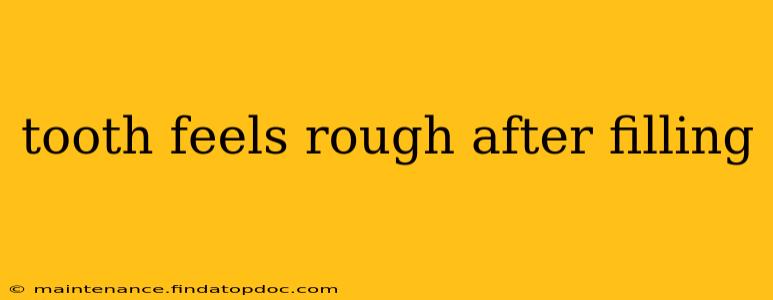A rough feeling after a dental filling is a common concern, and it's understandable to be worried. While it's often nothing serious, understanding the potential causes and when to seek professional help is crucial for maintaining your oral health. This article will explore the reasons why your tooth might feel rough after a filling, offering solutions and advice to ensure your comfort and long-term dental well-being.
Why Does My Tooth Feel Rough After a Filling?
Several factors can contribute to a rough sensation after a dental filling. The most common reasons include:
-
Excess Filling Material: During the filling process, your dentist might inadvertently leave behind excess filling material, leading to a rough or uneven surface. This is usually easily remedied by a quick adjustment.
-
Irritation from the Filling: Some individuals experience temporary irritation from the filling material itself, causing a slightly rough or sensitive feeling. This usually subsides within a few days.
-
Rough Edges of the Filling: Even with meticulous placement, the edges of a filling might be slightly rough, causing a noticeable texture. This again is easily corrected by your dentist.
What Should I Do If My Tooth Feels Rough After a Filling?
The first step is to contact your dentist. They can accurately assess the situation and determine the best course of action. Do not attempt to fix the problem yourself. Using abrasive materials or attempting to file down the filling could damage your tooth enamel and lead to further complications.
How Long Does the Roughness Usually Last?
The duration of the roughness varies depending on the cause. If the roughness is due to excess filling material or rough edges, your dentist can quickly smooth it out. In the case of irritation, the sensation might subside within a few days. If the roughness persists for more than a week or is accompanied by pain or sensitivity, it's crucial to seek professional dental attention.
Is it Normal for a Filling to Feel Slightly Rough?
A very slight roughness immediately after a filling is sometimes considered normal, as the filling material might not have fully settled. However, any noticeable roughness or unevenness warrants a follow-up appointment with your dentist for evaluation and adjustment.
Can I Brush My Teeth Normally After a Filling?
Yes, you can brush your teeth normally after a filling, using a soft-bristled toothbrush and gentle circular motions. However, avoid aggressive brushing, which could irritate the area or damage the filling.
When Should I See a Dentist About a Rough Filling?
You should schedule an appointment with your dentist if:
- The roughness persists for more than a few days.
- The roughness is accompanied by pain, sensitivity, or discomfort.
- You notice any chipping or cracking in the filling.
- You experience any changes in the way your bite feels.
Addressing a rough filling promptly prevents potential problems and ensures the longevity of your filling and your overall oral health. Remember, a quick check-up with your dentist can provide peace of mind and ensure your comfort.
What Happens During a Filling Adjustment?
The process of adjusting a filling is usually quick and painless. Your dentist will use specialized instruments to carefully smooth out any rough edges or excess material. This is typically a minor procedure requiring only a brief appointment.
This information is for general knowledge and does not constitute medical advice. Always consult with a qualified dental professional for any concerns about your oral health.
